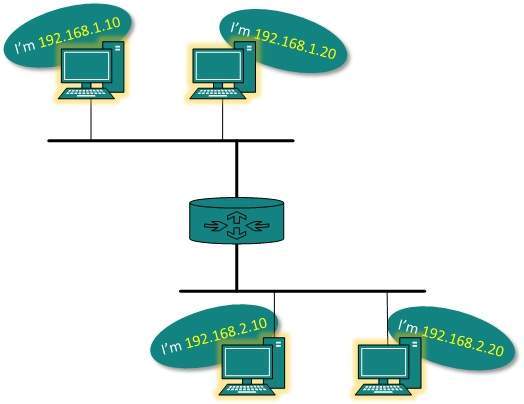
 Data Structure
Data Structure Networking
Networking RDBMS
RDBMS Operating System
Operating System Java
Java MS Excel
MS Excel iOS
iOS HTML
HTML CSS
CSS Android
Android Python
Python C Programming
C Programming C++
C++ C#
C# MongoDB
MongoDB MySQL
MySQL Javascript
Javascript PHP
PHP
- Selected Reading
- UPSC IAS Exams Notes
- Developer's Best Practices
- Questions and Answers
- Effective Resume Writing
- HR Interview Questions
- Computer Glossary
- Who is Who
Difference between MAC Address and IP Address
Both MAC Address and IP Address are used to uniquely identify a machine on the internet. MAC address is provided by the chip maker while IP Address is provided by the Internet Service Provider.
Mac Address
Media Access Control (MAC) address is a physical address that works at the data link layer of the OSI model.
A MAC address is a 48 or 64-bit address associated with a network adapter.
MAC addresses are linked to the hardware of the network adapters, hence they are also known as the "hardware address" or "physical address."
MAC addresses uniquely identify the adapter on the LAN.
MAC addresses are expressed in hexadecimal notation. For example, "01-23-45-67-89-AB" in a 48-bit address or "01-23-45-67-89-AB-CD-EF" in a 64-bit address. Sometimes, colons (:) are used instead of dashes (-).
MAC addresses are often considered permanent, but in some conditions, they can be changed.
There are three types of MAC addresses ?
Unicast MAC Address
Multicast MAC address
Broadcast MAC address
MAC Address Format
A 48-bit MAC address is represented as a string of six octets, "MM:MM:MM:SS:SS:SS".
The first half (24 bits) of the MAC address contains the ID number of the adapter manufacturer. These IDs are regulated by an Internet standards organization.
The second half (24 more bits) of the MAC address represents the serial number assigned to the adapter by the manufacturer.

As shown in the above diagram, MAC addresses are 12-digit hexadecimal numbers (48 bits in length or 6-byte binary number). For example, let's take a network adapter with the MAC address "00-A0-C9-14-C8-29." The OUI (Organizational Unique Identifier) for the manufacture of this router is the first three octets ("00-A0-C9") is Intel corporation and the rightmost six digits represent the Network Interface Controller.
OUIs of some well-known manufacturers ?
"00-14-22" - Dell
"00-04-DC" - Nortel
"3C:5A: B4" - Google, Inc.
IP Address
A network address always points to host / node / server or it can represent a whole network. Network address is always configured on network interface card and is generally mapped by system with the MAC address (hardware address or layer-2 address) of the machine for Layer-2 communication.
There are different kinds of network addresses in existence:
IP
IPX
AppleTalk

IP addressing provides mechanism to differentiate between hosts and network. Because IP addresses are assigned in hierarchical manner, a host always resides under a specific network.The host which needs to communicate outside its subnet, needs to know destination network address, where the packet/data is to be sent.
Hosts in different subnet need a mechanism to locate each other. This task can be done by DNS. DNS is a server which provides Layer-3 address of remote host mapped with its domain name or FQDN. When a host acquires the Layer-3 Address (IP Address) of the remote host, it forwards all its packet to its gateway. A gateway is a router equipped with all the information which leads to route packets to the destination host.
Routers take help of routing tables, which has the following information:
Method to reach the network
Routers upon receiving a forwarding request, forwards packet to its next hop (adjacent router) towards the destination.
The next router on the path follows the same thing and eventually the data packet reaches its destination.
Network address can be of one of the following:
Unicast (destined to one host)
Multicast (destined to group)
Broadcast (destined to all)
Anycast (destined to nearest one)
A router never forwards broadcast traffic by default. Multicast traffic uses special treatment as it is most a video stream or audio with highest priority. Anycast is just similar to unicast, except that the packets are delivered to the nearest destination when multiple destinations are available.
Differences
Following are the important differences between MAC Address and IP Address.
| Sr.No. | Key | MAC Address | IP Address |
|---|---|---|---|
| 1 | Definition | MAC Address stands for Media Access Control Address. | IP Address stands for Internet Protocol Address. |
| 2 | Usage | MAC Address ensure that physical address of the computer is unique. | IP Address is a logical address of the computer and is used to uniquely locate computer connected via a network. |
| 3 | Format | MAC Address is of six byte hexadecimal address. | IP Address is of 4 bytes or of 16 bytes. |
| 4 | Access Protocol | MAC Address can be retrieved using ARP protocol. | IP Address can be retrieved using RARP protocol. |
| 5 | Provider | Chip maker manufacturer provides the MAC Address. | Internet Service Provider, ISP provides the IP Address. |

